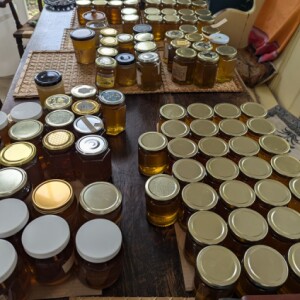The Reckoning
Since we extracted honey, it has been standing for three days in two plastic containers, each with a large guillotine-tap at the bottom. Today we transferred it to jars (some new, some recycled), stacked the jars in boxes and put the boxes in the shed. The standing period allows any tiny thing that has eluded the various filters to fall to the bottom or, along with fine bubbles in the honey, float to the top
Honey from the tap is then clear and bubble-free in the jars - that is until the container is nearly empty, when the bubbles start to flow out with the last of the honey. We make sure this end-of-line stuff goes into recycled jars for us to use - it's perfectly edible, it just looks a bit less 'perfect'. The flow into the jar produces these abstract patterns as the honey folds in. They are not permanent, as the bubbles float to the top and form a froth
There is a trick to avoid having bubbles in the last jar or two. If a layer of cling-film is laid carefully across the surface of the container during the settling period (meticulously excluding any air under the film and ensuring contact with the honey over the entire surface), the film can then be removed by gripping it in the centre of the container, and lifting it off like a magician revealing the white rabbit. The film is then very sticky and drippy with honey, that can either be discarded or squeezed out as a frothy mass and used for cooking. The technique works well, and we have done it a few times, but I've decided I'd rather avoid the sticky mess and have a few slightly frothy jars
The total yield is around 35kg which, in the circumstances, we find quite astonishing


Comments
Sign in or get an account to comment.


